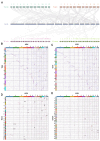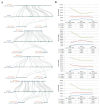Construction of Ancestral Chromosomes in Gymnosperms and the Application in Comparative Genomic Analysis
- PMID: 40805710
- PMCID: PMC12349002
- DOI: 10.3390/plants14152361
Construction of Ancestral Chromosomes in Gymnosperms and the Application in Comparative Genomic Analysis
Abstract
Chromosome rearrangements during plant evolution can lead to alterations in genome structure and gene function, thereby influencing species adaptation and evolutionary processes. Gymnosperms, as an ancient group of plants, offer valuable insights into the morphological, physiological, and ecological characteristics of early terrestrial flora. The reconstruction of ancestral karyotypes in gymnosperms may provide critical clues for understanding their evolutionary history. In this study, we inferred the ancestral gymnosperm karyotype (AGK), which comprises 12 chromosomes, and conducted a collinearity analysis with existing gymnosperm genomes. Our findings indicate that chromosome numbers have remained remarkably stable throughout the evolution of gymnosperms. For species with multiplied chromosome numbers, such as gnetophytes, weak collinearities with the AGK were observed. Comparisons between the AGK and gnetophyte genomes revealed a biased pattern regarding retained duplication blocks. Furthermore, our analysis of transposable elements in Welwitschia mirabilis identified enriched regions containing LINE-1 retrotransposons within the syntenic blocks. Syntenic analysis between the AGK and angiosperms also demonstrated a biased distribution across chromosomes. These results provide a fundamental resource for further characterization of chromosomal evolution in gymnosperms.
Keywords: LINE-1; ancestral karyotype; chromosome stability; collinearity; gymnosperm.
Conflict of interest statement
The authors declare no conflict of interest.
Figures






Similar articles
-
Prescription of Controlled Substances: Benefits and Risks.2025 Jul 6. In: StatPearls [Internet]. Treasure Island (FL): StatPearls Publishing; 2025 Jan–. 2025 Jul 6. In: StatPearls [Internet]. Treasure Island (FL): StatPearls Publishing; 2025 Jan–. PMID: 30726003 Free Books & Documents.
-
Can a Liquid Biopsy Detect Circulating Tumor DNA With Low-passage Whole-genome Sequencing in Patients With a Sarcoma? A Pilot Evaluation.Clin Orthop Relat Res. 2025 Jan 1;483(1):39-48. doi: 10.1097/CORR.0000000000003161. Epub 2024 Jun 21. Clin Orthop Relat Res. 2025. PMID: 38905450
-
The genome of Hippophae salicifolia provides new insights into the sexual differentiation of sea buckthorn.Gigascience. 2025 Jan 6;14:giaf046. doi: 10.1093/gigascience/giaf046. Gigascience. 2025. PMID: 40601420 Free PMC article.
-
Factors that influence parents' and informal caregivers' views and practices regarding routine childhood vaccination: a qualitative evidence synthesis.Cochrane Database Syst Rev. 2021 Oct 27;10(10):CD013265. doi: 10.1002/14651858.CD013265.pub2. Cochrane Database Syst Rev. 2021. PMID: 34706066 Free PMC article.
-
Comparative genomics approach to infer ancestral cell karyotypes and reconstruct the evolutionary trajectories of plant chromosomes.Nat Protoc. 2025 Aug 1. doi: 10.1038/s41596-025-01173-5. Online ahead of print. Nat Protoc. 2025. PMID: 40750714 Review.
References
-
- Zhang K., Wang X., Cheng F. Plant Polyploidy: Origin, Evolution, and Its Influence on Crop Domestication. Hortic. Plant J. 2019;5:231–239. doi: 10.1016/j.hpj.2019.11.003. - DOI
-
- Liu J., Zhou S.Z., Liu Y.L., Zhao B.Y., Yu D., Zhong M.C., Jiang X.D., Cui W.H., Zhao J.X., Qiu J., et al. Genomes of Meniocus linifolius and Tetracme quadricornis reveal the ancestral karyotype and features of core Brassicaceae. Plant Commun. 2024;5:100878. doi: 10.1016/j.xplc.2024.100878. - DOI - PMC - PubMed
-
- Tkach N., Winterfeld G., Roeser M. Genome sizes of grasses (Poaceae), chromosomal evolution, paleogenomics and the ancestral grass karyotype (AGK) Plant Syst. Evol. 2025;311:4. doi: 10.1007/s00606-024-01934-x. - DOI
Grants and funding
LinkOut - more resources
Full Text Sources

